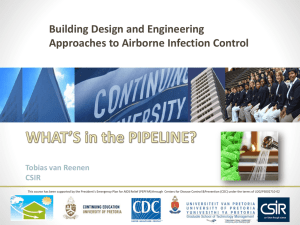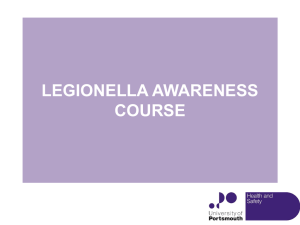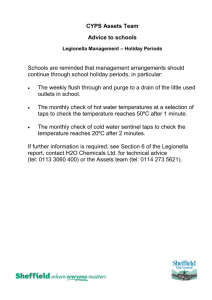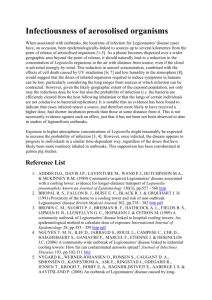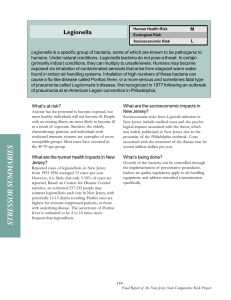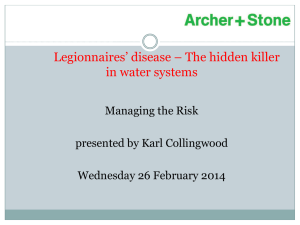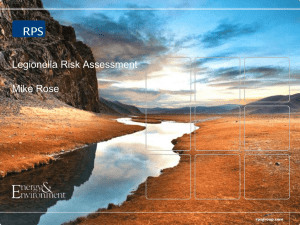by B.A., University of Pittsburgh, 2015 Submitted to the Graduate Faculty of
advertisement
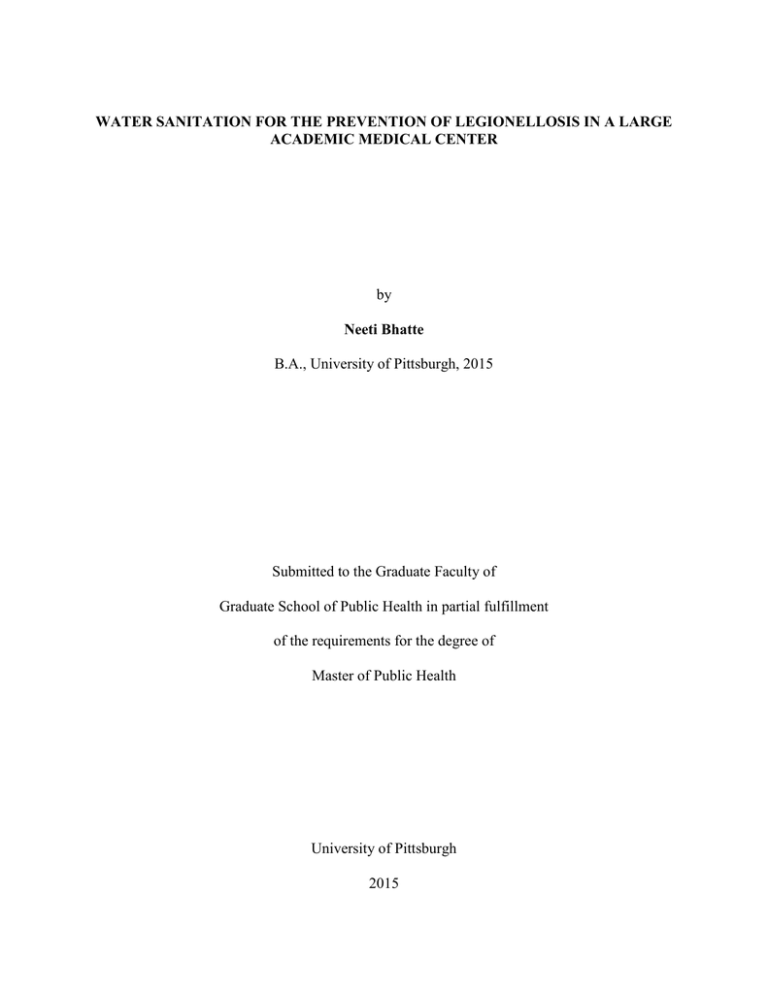
WATER SANITATION FOR THE PREVENTION OF LEGIONELLOSIS IN A LARGE ACADEMIC MEDICAL CENTER by Neeti Bhatte B.A., University of Pittsburgh, 2015 Submitted to the Graduate Faculty of Graduate School of Public Health in partial fulfillment of the requirements for the degree of Master of Public Health University of Pittsburgh 2015 i UNIVERSITY OF PITTSBURGH GRADUATE SCHOOL OF PUBLIC HEALTH This essay is submitted by Neeti Bhatte on December 2nd, 2015 and approved by Essay Advisor: Lawrence Kingsley, DrPH ______________________________________ Professor, Infectious Diseases and Microbiology Graduate School of Public Health University of Pittsburgh Essay Reader: Mohamed Yassin, MD PhD Director of Infection Control UPMC Mercy Pittsburgh, Pennsylvania ______________________________________ ii Copyright © by Neeti Bhatte 2015 iii Lawrence Kingsley, DrPH WATER SANITATION FOR THE PREVENTION OF LEGIONELLOSIS IN A LARGE ACADEMIC MEDICAL CENTER Neeti Bhatte, MPH University of Pittsburgh, 2015 ABSTRACT Legionella pneumophila is a bacterium that can cause severe pneumonia by exposure to contaminated water. It is relatively resistant to common water disinfection, so additional prevention measures for healthcare water systems are needed to prevent Legionellosis in severely-ill and immune compromised patients. In the United States, copper silver ionization and chlorine are the most common systems for water disinfection. University of Pittsburgh Medical Center Mercy was the first large medical system in the United States to use monochloramine for Legionella water disinfection for over four years now. This paper is a descriptive and long-term retrospective study of Legionella water disinfection that shows the effectiveness of monochloramine treatment on a large academic medical center water system since its installation in 2011. Legionella water culture data collected by the Mercy Microbiology Laboratory began in March 2011 at UPMC Mercy and is currently an ongoing project. This data is unique as it is the longest follow up data available in the United States. It is collected by the Mercy Microbiology Lab as well as the Special Pathogens Laboratory for UPMC. The paper will include a review of general water treatment methods and the importance of supplementary treatment for Legionella at healthcare facilities. The methods will include the overall plan for Legionella water culture iv frequency used at UPMC Mercy based on risk assessment, different methodologies of water culture that were studied in the same institution, and the protocols followed for positive cultures and complications that were faced while the treatment was in place at the medical center. The practical lessons learned and the results are of significant importance to public health as well as healthcare precautions. This study also helped address the risk assessment for frequency of Legionella testing and different methods of testing, so it has also been a catalyst for a more controlled and consistent method of treatment in state and county health regulations. Further studies may include eliminating any complications associated with the use of monochloramine and considering a monochloramine treatment system for city-wide or other widespread area usage. v TABLE OF CONTENTS INTRODUCTION TO LEGIONNAIRES’ DISEASE ............................................. 1 1.0 1.1 SYMPTOMS AND TRANSMISSION ............................................................... 2 1.2 IMMUNOPATHOGENESIS .............................................................................. 2 1.2.1 Innate Response ............................................................................................... 2 1.2.2 Adaptive Response ........................................................................................... 3 1.3 PATHOPHYSIOLOGY OF PNEUMONIA ..................................................... 5 1.4 TREATMENT AND PREVENTION ................................................................ 6 2.0 BACKGROUND ON WATER DISINFECTION ..................................................... 7 2.1 PUBLIC HEALTH SIGNIFICANCE................................................................ 7 2.2 COMMON WATER DISINFECTION METHODS ........................................ 9 3.0 LEGIONELLA-SPECIFIC WATER DISINFECTION ........................................ 11 3.1 PUBLIC HEALTH SIGNIFICANCE.............................................................. 11 3.2 COMMON LEGIONELLA-SPECIFIC WATER DISINFECTION METHODS .......................................................................................................................... 12 3.2.1 4.0 Water Temperature Control ........................................................................ 13 METHODS ................................................................................................................. 15 4.1 WATER CULTURE METHODS FOR LEGIONELLA COLONIZATION 15 4.2 ROUTINE CULTURE PLAN .......................................................................... 17 vi 4.3 5.0 PROTOCOL FOR POSITIVE CULTURES .................................................. 18 RESULTS ................................................................................................................... 19 5.1 SPECIAL PATHOGENS LABORATORY RESULTS ................................. 19 5.2 UPMC MERCY MICROBIOLOGY LABORATORY RESULTS .............. 21 6.0 DISCUSSION ............................................................................................................. 23 6.1 COMPLICATIONS ........................................................................................... 23 6.1.1 Monitoring Monochloramine Levels ........................................................... 24 6.1.1.1 Nitrification.......................................................................................... 24 6.2 6.1.2 Construction Issues........................................................................................ 25 6.1.3 Automatic Water Faucets ............................................................................. 26 6.1.4 Piping Material .............................................................................................. 26 FURTHER STUDIES AND IMPLICATIONS ............................................... 27 BIBLIOGRAPHY ....................................................................................................................... 29 vii LIST OF TABLES Table 1. Common Disinfection Methods, ..................................................................................... 10 Table 2. Underlying Conditions of Persons with Confirmed Legionellosis Infection (n =1,426) 12 Table 3. Monthly Legionella Culturing Schedule......................................................................... 17 Table 4. Swab Sample Sizes for the First Months of the Study ................................................... 22 viii LIST OF FIGURES Figure 1. Legionella Colonization on a BCYE Agar Plate ........................................................... 16 Figure 2. Special Pathogens Lab Legionella Distal Site Positivity, .............................................. 20 Figure 3. UPMC Mercy Microbiology Lab Legionella Distal Site Positivity .............................. 21 ix 1.0 INTRODUCTION TO LEGIONNAIRES’ DISEASE Legionnaires’ disease is a severe form of lung inflammation caused by the agent Legionella pneumophila, a gram negative bacterium. To clarify terms, Legionellosis is any illness caused by L. pneumophila, and it includes Legionnaires’ disease as well as Pontiac fever, a milder flulike illness. The name Legionnaires’ disease comes from an outbreak of pneumonia that killed 29 people at an American Legion Convention in Philadelphia in 1976.1 The etiologic agent was discovered in 1977, and it has since been associated with outbreaks linked to poor water sanitation, infected air ducts, etc. 2 L. pneumophila is one of the most common causes of pneumonia, and each year, between 8,000 and 18,000 people are hospitalized with Legionnaires' disease in the U.S.3 Worldwide, waterborne Legionella pneumophila is the most common cause of outbreaks with varying severities. Even in the United States, sometimes symptoms are overlooked, and this disease is often under-reported. Legionella is especially of great concern for immunocompromised patients, and hence hospitals and elderly living communities are of priority when it comes to Legionella sanitation and prevention. Common disinfectants, such as chlorine, do not rid water systems of the bacterium, so it is important for hospitals to apply supplemental or secondary disinfection techniques. This paper describes how monochloramine water treatment has been effective at a single large academic medical center and discusses the practical challenges associated with monochloramine usage. A further study of the infectious disease and its pathology reveals its importance, especially to an immunocompromised population. 1 1.1 SYMPTOMS AND TRANSMISSION Legionnaire’s disease has many symptoms similar to other forms of pneumonia, so it can be difficult to diagnose early and at first sight. The incubation period of the bacteria is variable from person-to-person, and so symptoms can be seen anytime between 2 to 14 days of exposure to the bacteria.3 Initially, symptoms are fever, headache, chills, and lethargy. After a couple days, other symptoms can include loss of appetite, muscle pain, cough, and diarrhea. Some patients may also experience nausea, vomiting, chest pain, and confusion.4 Legionnaires’ disease worsens during the first week, and the severity of disease ranges from a mild cough to a rapidly fatal pneumonia. Although symptoms can last for months, untreated, the progressive pneumonia can lead to respiratory failure, shock, or multi-organ failure resulting in death.2 The severity depends on many factors, but predominantly relies on host factors, dose of causative agent, and how quickly the disease is diagnosed and treated. Legionnaire’s disease cannot be spread from person-to-person contact. Rather it is spread from inhaling droplets of vapor carrying the bacteria. Infection can occur by aspiration of contaminated water, such as in sinks, shower heads, or hot water reservoirs.2 1.2 IMMUNOPATHOGENESIS 1.2.1 Innate Response As the first line of defense, when droplets are breathed in, the body’s mucociliary actions prevent Legionella pneumophila from reaching the upper respiratory tract. Hence, any process that 2 inhibits or hinders mucociliary actions, such as smoking, increases the chance for infection. Additionally, there are many strains of the species, and some have been discovered to have mechanisms that allow it to adhere to respiratory epithelial cells. Once the bacterium enters the body, a cascade of events occurs in the immune system. In the alveoli of the lungs, macrophages act to engulf the organism. Before phagocytosis can occur, antibodies first need to be created in order to help opsonize the bacteria. Humoral antibodies develop readily to these bacteria in infected patients as well as in people who have had subclinical exposure. For example, if a patient had been exposed to a low dose of Legionella without showing clinical presentations, repeated exposure will result in quick antibody production. High-levels of serum antibodies may also occur in individuals who had previously recovered from the infection.5 Although macrophages engulf the organism, they do not readily kill it. In contrast, L. pneumophila multiply intracellularly in macrophages until the cell ruptures. The bacteria from the ruptured cell can then go on to infect other macrophages. As mentioned before, there are many strains of the bacteria, and several of those have strains that inhibit opsonization by macrophages and promote intracellular growth. They do so by inhibiting the formation of phagolysosome, the method by which macrophages kill the bacteria, after phagocytosis.6 In reality then, macrophages may be involuntarily supporting the growth of Legionella. 1.2.2 Adaptive Response So it comes as no surprise that the body relies more heavily on cell-mediated immunity, which is part of the immune response that does not involve antibodies, but rather involves the release of cytokines in response to the specific antigen. Active macrophages release cytokines that regulate 3 antimicrobial activities and call various immune cells to the site of infection. One type of those cells is the natural killer cells. They release a cytokine called interferon gamma (IFN- γ).7 IFN- γ is an important activator of macrophages and an inducer of Class I major histocompatibility complex (MHC) molecule expression. This activation of macrophages allows them to overcome the inhibition of phagolysosome formation, and the bacteria can no longer stay alive inside the macrophage cells.8 Other important immune cells that are summoned to the site are helper T cells. There are two types of helper T cells, and a recent paper summarizes their different actions: “Th 1 type helper cells that produce type 1 class cytokines, such as interferon gamma and interleukin-2 (IL2), are known to be important in cellular immunity to Legionella as well as to other opportunistic intracellular bacteria. In contrast, Th 2 type helper cells, which secrete type 2 class cytokines such as IL-4, IL-5, and IL-6, activate B lymphocytes to produce humoral antibodies important in resistance to extracellular bacteria which secrete toxins and extracellular factors as compared to intracellular bacteria such as Legionella.”5 Like macrophages, immature dendritic cells in the lungs are also infected by the bacteria. The bacteria within the cell are not killed, but only prevented from further growth. The dendritic cells then go through maturation and produce Legionella antigens. Both macrophages and dendritic cells are immune cells that present antigens to the T cells of the immune system. This allows the T cells to produce IFN-γ, like the natural killer cells, which further assists in the removal of the infectious agent.7 In many mammals, these responses are sufficient in preventing the infection from becoming a fully symptomatic disease. However, the human innate immune system does not 4 help much in the fight. By the time the adaptive immune response is initiated, the bacteria often gain a solid foothold in the lungs. 1.3 PATHOPHYSIOLOGY OF PNEUMONIA L. pneumophila is one of the most common agents that cause pneumonia. The bacteria cause all the immune responses mentioned above in addition to several other interconnected responses as well. According to a medical definition, pneumonia is “an infectious process resulting from the invasion and overgrowth of microorganisms in the lung parenchyma, breaking down defenses and provoking intra-alveolar exudates.”9 Hence in Legionnaires’ disease, at the site of the lung parenchyma, the white blood cells are forced to migrate out of the capillary and into the air space to fight the infection.10 This pool of masses of cells causes an acute inflammation that result in coughing, phlegm, etc. Although largely considered a respiratory illness, serious cases of Legionnaires’ disease can also cause multi-organ failures, leading to death. Risk factors for Legionnaires’ disease include smoking, alcohol consumption, recent surgery, weakened immune systems, diabetes, and chronic predisposed lung diseases. The most susceptible hosts are immuno-compromised patients, including organ transplant recipients and cancer patients.2 Studies on this are summarized in Table 2 of chapter three. 5 1.4 TREATMENT AND PREVENTION Legionnaires’ disease can be treated with antibiotics in most cases. Antibiotics that work on bacterial cell walls, such as penicillin, have no effect on Legionella. Rather classes like the fluoroquinolones, that alter protein synthesis, are the most effective. In severe cases, treatment requires hospitalization, and like most treatments, the sooner the medication is started the better. A variety of antimicrobial therapies exist, and depending on the severity, most of them take 2-3 weeks to alleviate the infection. Individually, there is not much that can be done to prevent the disease other than avoiding the risk factors. On a wider scale however, many hospitals, pools, and other large scale water systems must take greater precautions in preventing an outbreak. Water disinfection, temperature monitoring, and frequent water quality tests ensure that the systems are free of L. pneumophila.11 The next chapter will cover common methods of water disinfection and its importance on a greater scale. 6 2.0 BACKGROUND ON WATER DISINFECTION The bacterium L. pneumophila is particularly dangerous to those with vulnerable immune systems. Thus it is generally not a necessity to have a disinfectant targeting it in normal faucet water, but is a must in places such as hospitals or elder living communities. So, before delving into Legionella-specific water treatment, this chapter focuses on the importance of general water management and some common methods. The next chapter will look at issues specifically centered on Legionella and its disinfection. 2.1 PUBLIC HEALTH SIGNIFICANCE Water sanitation is one of the most important public health initiatives undertaken worldwide. Disinfection kills or inactivates many disease-causing organisms, and on a public health level, the quality of drinking water is an influential environmental determinant of health. Not only does clean water include low levels of disease-causing bacteria, but it also entails keeping chemicals and other harmful natural elements in check. According to the World Health Organization (WHO), “Water-related diseases include: - those due to micro-organisms and chemicals in water people drink; - diseases like schistosomiasis which have part of their lifecycle in water; 7 - diseases like malaria with water-related vectors; drowning and some injuries; - and others such as legionellosis carried by aerosols containing certain microorganisms.”12 Many rules and guidelines are put in place by the Environmental Protection Agency (EPA) in the United States to ensure the prevention and control of waterborne diseases and other harmful health effects. With the Safe Drinking Water Act (SDWA), the EPA sets legal limits on the baseline level of certain contaminants, and it also determines acceptable methods of treatment. For example, on June 7, 1991, EPA published a regulation to control lead and copper in drinking water. Exposure to lead and copper can cause anything between gastritis to brain damage. “The treatment technique for the rule requires systems to monitor drinking water at customer taps. If lead concentrations exceed an action level of 15 ppb or copper concentrations exceed an action level of 1.3 ppm in more than 10% of customer taps sampled, the system must undertake a number of additional actions to control corrosion. If the action level for lead is exceeded, the system must also inform the public about steps they should take to protect their health and may have to replace lead service lines under their control.”13 Even within this umbrella, there are many more specific details describing the Lead and Copper Rule. Water treatment becomes even more stringent in areas such as hospitals or elder living communities. As seen in the previous chapter, normal immune systems have innumerable ways of defending the body against pathogens; however, such is not the case in immunocompromised patients and those with an overall weaker immune response. 8 2.2 COMMON WATER DISINFECTION METHODS Water treatment involves coagulation, sedimentation, and filtration before disinfectants can be added. A variety of disinfection methods are used, and when combined with the other conventional steps, they are very effective in different ways. The following table compares different disinfection methods. 9 Table 1. Common Disinfection Methods14,15 Characteristics Process Advantages Disadvantages Chlorination (gas) At normal pressures, elemental chlorine is a toxic, yellow-green gas, and is liquid at high pressures. Highly pressurized water is passed through a supply pipe and draws the chlorine into the water stream. Adequate mixing and contact time must be provided after injection to ensure complete disinfection of pathogens. Chlorine is very effective for removing almost all microbial pathogens Chlorine is a dangerous gas that is lethal at concentrations as low as 0.1 percent air by volume. It may be necessary to monitor the pH of the water Sodium hypochlorite solution Sodium hypochlorite is available as a solution in concentrations of 5 to 15 percent chlorine, and is commonly known as bleach. Calcium hypochlorite is a white solid that contains 65 percent available chlorine and dissolves easily in water. Sodium hypochlorite solution is diluted with water in a mixing tank and its corrosive nature disinfects pathogens. Sodium hypochlorite is easier to handle than gaseous chlorine or calcium hypochlorite Storage can be difficult and is more expensive than chlorine gas Calcium hypochlorite is generally dissolved in a mixing tank and injected in the same manner as sodium hypochlorite. When packaged, calcium hypochlorite is very stable, and can be bought and stored in bulk. Chloramines are formed when water containing ammonia is chlorinated or when ammonia is added to water containing chlorine Ozone, an allotrope of oxygen having 3 atoms to each molecule, is a powerful oxidizing and disinfecting agent Chlorine is injected into the supply main followed immediately by injection of ammonia. The pH and ratio of the products are monitored. Monochloramine is an effective bactericide that produces fewer byproducts. The oxidation process involves the production of very reactive oxygen species that are able to attack a wide range of organic compounds. It breaks the cell wall of microorganisms and affects their nucleic acid structures. When it penetrates the cell wall of an organism, the cell’s genetic material is disrupted. It specifically disrupts DNA processing and blocks protein synthesis. Hence the cell is unable to reproduce. It requires a shorter contact time and dosage than chlorine. Storage can be difficult and has a strong odor. It must be kept away from organic material so containers must be carefully handled. As a weak disinfectant, it is much less effective against viruses than free chlorine. It is mainly used as a secondary disinfectant to prevent bacterial regrowth. Ozone gas is unstable and must be generated onsite. Calcium hypochlorite Monochlora mine Ozonation U.V. Radiation Ultraviolet (UV) light is an electromagnetic radiation that is generated by a special lamp. 10 UV radiation effectively destroys bacteria and viruses. It is readily available and produces no known toxic residuals. As with ozone, a secondary disinfectant must be used to prevent regrowth of microorganisms. UV radiation does not inactivate all protozoans and is not suitable for water containing organic material. 3.0 LEGIONELLA-SPECIFIC WATER DISINFECTION 3.1 PUBLIC HEALTH SIGNIFICANCE Although the exact incidence of legionellosis worldwide is unknown, due to differing methods of identification and reporting in various countries, an estimated 8,000 to 18,000 people need care in a hospital due to Legionnaires' disease each year in the United States.16,3 However, many cases of legionellosis are not diagnosed since the symptoms are not recognizably unique, so these numbers may as well be higher. Legionellosis is a nationally notifiable disease that is monitored through two surveillance systems at the national level: Nationally Notifiable Diseases Surveillance System (NNDSS) and Supplemental Legionnaires’ Disease Surveillance System (SLDSS). NNDSS data reports that there was a 249% increase in crude incidence of legionellosis in the United States within nearly a decade, from 0.39 in 2000 to 1.36 cases per 100,000 persons in 2011.17 While this may not seem like a high rate compared to other infectious diseases in the United States, the case fatality rate for healthcare associated Legionella is anywhere between 28-48%.18,19 As seen in Table 2, it is evident that immunocompromised people account for a significant proportion of the confirmed legionellosis cases identified through the Active Bacterial Core (ABC) surveillance from 2011 to 2013. 11 Table 2. Underlying Conditions of Persons with Confirmed Legionellosis Infection (n =1,426)20 Underlying Condition Number Percent (%) Current smoker 544 38.1 Diabetes 421 29.5 Chronic obstructive pulmonary disease 232 16.3 Immunocompromised 200 14.0 Former smoker 197 13.8 Heart failure 163 11.4 Alcohol abuse 119 8.3 These main underlying conditions were documented in the medical record during legionellosis admission and captured by ABC’s abstractors. Of those that were immunocompromised, 12 had acquired immunodeficiency syndrome (AIDS), one had complement deficiency, three had immunoglobulin deficiency, eight had asplenia, and 176 were on immunosuppressive therapy.20 Hospital-acquired Legionnaires' disease has been reported from many hospitals since the first outbreak in 1976. Yet, this disease is easily preventable with routine environmental cultures of the water supply coupled with an efficient long-term disinfection method for the hospital water systems. 3.2 COMMON LEGIONELLA-SPECIFIC WATER DISINFECTION METHODS L. pneumophila grows best in warm, stagnant waters. These situations occur in cooling towers, water reservoirs, and even water features such as decorative water fountains. Common 12 disinfection methods used to protect against Legionella include copper silver ionization, hyperchlorination, point-of-use filters, and monochloramine.21 Compared to other methods of disinfection, monochloramine is the most promising due to its ability to penetrate biofilm, reach distal sites (such as patient tap water), and be efficient over a wide pH range.21 It is stable and has shown that it does not lead to the increase of other microorganisms or harmful elements. 3.2.1 Water Temperature Control In addition to the methods listed in Table 1, an easy form of disinfection is temperature control. The bacterium L. pneumophila has been found in water with temperatures ranging from 6°C 60°C (42.8°F-140°F). It will not multiply below 20°C (68°F) and dies above 60°C (140°F). Bacteria at 37°C (98.6°F) are more infectious than the same bacteria at 25°C (77°F), meaning that warm water between 20°C (68°F) and 45°C (113°F) is the perfect place for the bacteria to multiply.22 A study recently done in Taiwan addressed neonatal legionellosis associated with the water used to make infant formula. Even though the hot water faucet provided boiled water at 95-100°C, the cold water was coming from the same dispenser. After two cases were identified in different hospitals, one hospital mounted a point-of-use filter on the faucets in the nursery, while the other hospital removed the cold water source of the hot and cold water dispenser.23 This huge difference in actions taken by each hospital shows how more data needs to be available to build regulations around hospital water treatment. In previous instances of L. pneumophila contamination, hospitals have tried anything from superheating water used in all patient care areas to 75°C for 72 hours, to raising the hot 13 water storage tank temperature from 43°C to 52°C.24 However, attempts at solely increasing water temperatures have been shown to have limited success with concern for scalding injuries and short-lived efficacy.21 14 4.0 METHODS UPMC Mercy is a 12-story teaching hospital in Pittsburgh, PA. Legionella pneumophila serogroup 1 was detected in the hospital’s hot water system in the early 1990s, which prompted the installation of a copper-silver ionization system. After a building renovation project in 2010, Legionella colonization was found to increase after this construction despite the water treatment system in place. This prompted the investment of a newer monochloramine disinfection system. Provided by Sanipur, a company in Brescia, Italy, this was installed on the hot water system of the hospital in September of 2011. The system generated monochloramine on site by combining two reagents, a stabilized chlorine precursor and a buffered ammonium salt solution. These chemicals were injected into a tube that supplied the treated water to the building’s hot water circulation.25 4.1 WATER CULTURE METHODS FOR LEGIONELLA COLONIZATION Routine culture and surveillance of hospital water is crucial in monitoring legionella colonization. Prior studies done at the same institution compared the swab technique and the large volume technique. Swab samples are collected from distal outlets throughout the hospital. Hot water is left running for a few minutes, and a swab is then inserted 2-3 inches into the spigot to collect the 15 biofilm sample. The swab is then inserted into a tube that contains 10 mL of hot water from the same site. The tubes are vortexed, and 0.1 mL of the sample is plated onto a selective agar plate – DGVP (dyes, glycine, vancomycin, polymycin B) or BCYE (buffered charcoal yeast extract). These selective growth media are used to culture gram-negative species like Legionella pneumophila. Below is an example of a plate with positive results of colonization on a BCYE agar plate. Figure 1. Legionella Colonization on a BCYE Agar Plate Another method is the large volume method that tests the planktonic bulk water rather than the surface biofilm. 100 mL of distal hot water is collected immediately upon opening each tap, and cold water samples are collected after 1 minute of flushing.Error! Bookmark not defined. The sample is spun and the supernatant is decanted to culture 0.1 mL. The plates are stored at 37 °C for 7 weeks to examine for any bacterial growth. The colony-forming units are then counted to estimate the quantity of viable bacteria. Previous studies have shown that the swab samples showed a lower distal site positivity compared to large water samples during both the baseline and post-disinfection periods, indicating that bulk water monitoring of Legionella provides greater sensitivity than using swab samples.25 However, experiments have shown that the swab method is the easiest and most cost 16 efficient way of collecting environmental water samples without losing much accuracy. Centrifugation of large volumes of water increases the detection level but also requires higher skill, higher costs, and more time to process for a microbiology lab.26 4.2 ROUTINE CULTURE PLAN The bulk water method was used at the Special Pathogens Lab. Baseline testing was done four times before the monochloramine system installation, and post-infection it was done monthly for first six months and then every two months for 18 months. Distal outlets sampled during the post-disinfection period included 18 dual-supply sinks, 2 showers, and 7 sensor faucets.25 The swab method was used at the UPMC Mercy Microbiology Lab, and a simplified example of the culture schedule is seen in Table 3. Table 3. Monthly Legionella Culturing Schedule High-risk Units Low-risk Units Month A B C D E January x x x x x February x x x x x March x x x x … x x x F x Sampling locations were rotated monthly as seen in the table above. Everyone month, culture samples are taken from different distal outlets within each unit identified above. The letters represent different units classified as either high-risk or low-risk. Through risk 17 assessment, it was determined that high-risk units were those such as the Intensive Care Unit, Cardiovascular Intensive Care Unit, and Burn Unit. Lower risk units include the Post-Anesthesia Care Unit, Neonatal Intensive Care Unit, and other inpatient rooms. Extra samples are taken from outlets that had positive samples in the prior month. 4.3 PROTOCOL FOR POSITIVE CULTURES If a positive Legionella culture is found, the Microbiology lab notifies the hospital’s Infection Control Department. The species sample is tested with direct fluorescent antibody (DFA) staining to confirm the identity of L. pneumophila.27 If it is not confirmed, follow up action may still be required in the following months to monitor colony counts at that location. If it is confirmed, then the action taken is dependent on the area affected and the amount of Legionella colonization. The following general guidelines are followed succeeding a positive culture result: - Remove fixture - Hyperchlorination - Flush with hot water - Reculture In addition to re-culturing, the Engineering and Maintenance Department (EMD) is responsible for ensuring monochloramine levels and checking for any mechanical issues. For more serious issues, a special task force is put together to decide further actions, such as prohibiting patient admittance to certain rooms. 18 5.0 5.1 RESULTS SPECIAL PATHOGENS LABORATORY RESULTS The Special Pathogens Lab used the method of large volume water samples when testing for Legionella colonization. Baseline testing was done in April, May, June, and September of 2011, and the baseline average percentage of positive distal sites was 53%. This decreased to 6% within one week and remained below 10% for the first 18 months of the study. It increased during months 10 and 12, and corrective actions were taken after the cause was discovered. The issue will be discussed in section 6.1 under complications.25 19 Figure 2. Special Pathogens Lab Legionella Distal Site Positivity28,25 For the baseline study, a total of 110 samples were taken over the period of four testing days (n=110), and every monthly sample after included 27 distal outlets (n=27). A significant reduction in Legionella distal site positivity was observed between the pre- and post-disinfection periods, with a positivity decreasing from an average of 53% (baseline) to an average of 9% after monochloramine application. Since other microbes and chemical changes were also monitored as a part of this study, it is worthy to note that no significant changes in other microbial populations were observed.25 20 5.2 UPMC MERCY MICROBIOLOGY LABORATORY RESULTS The UPMC Mercy Microbiology Lab utilizes the swab method and still is an ongoing study to monitor for Legionella colonization, making it the longest follow up data available in the United States. Baseline testing was done monthly from March to September of 2011. The percentage of positive distal sites decreased from an average baseline level of 27% to 0% within a month. It has remained at 0%. Figure 3. UPMC Mercy Microbiology Lab Legionella Distal Site Positivity For the baseline study, a total of 188 swab samples were collected (n=188). Only the first ten months were included in the graph to avoid redundancy and the sample sizes varied per month as seen in the following table: 21 Table 4. Swab Sample Sizes for the First Months of the Study Month n (swab samples collected) October 2011 28 November 2011 27 December 2011 20 January 2012 17 February 2012 22 March 2012 17 April 2012 21 May 2012 22 June 2012 17 July 2012 18 A significant reduction in Legionella distal site positivity was observed between the preand post-disinfection periods, with a positivity decreasing from an average of 27% (baseline) to an average of 0% after monochloramine application. The sensitivity of this study method resulted in lower positivity percentages than compared to those seen with a bulk water method; however, it still served the purpose of being a quick and efficient method of testing for the presence of Legionella colonization. 22 6.0 DISCUSSION Illness caused by Legionella continues to be detected, now more than ever. The key to preventing legionellosis is maintenance of the water systems in which Legionella grow, including drinking water systems, hot tubs, decorative fountains, and cooling towers. Because the bacteria can survive in varied environments, making sure that water systems have the right disinfectant and that the right levels are maintained is essential. Conclusively seen from both laboratorial results, applying monochloramine to the hot water system of a hospital water system was shown to be effective in controlling Legionella colonization and has prevented cases of hospital-acquired Legionnaires’ disease. Regular monitoring of monochloramine, ammonia, and metal ions is required to ensure optimal efficacy. 6.1 COMPLICATIONS The following complications are a result of the practical lessons learned and background research done. Previous investigations done at other facilities have aided UPMC Mercy to avoid the same issues. The descriptive study includes a report of those issues as well as the ones experienced at UPMC Mercy in the past so as to hopefully avoid them in the future. 23 6.1.1 Monitoring Monochloramine Levels The onsite generation of monochloramine is something that can cause a chemical imbalance if not monitored properly. Recall months 10-12 in the results found by the Special Pathogens Lab (Figure 2). The distal site positivity spiked when the two reagents, a stabilized chlorine precursor and a buffered ammonium salt solution, were not combined at the right proportions. The chlorine reagent degenerated over time due to high temperatures in the storage area, and the imbalance led to an excess of free ammonia in the hot water system. The tank was cleaned and replaced with new reagents, which led to lower distal site positivity once again. The lab began to monitor free ammonia as well so that in the event that this happens again, the cause can be determined faster.25 6.1.1.1 Nitrification Nitrification is the process by which ammonia is oxidized to nitrite and is performed by a small group of microorganisms found in biofilm. These reactions lead to water quality degradation and the depletion of monochloramine disinfection in the water. The exact process is unknown; nonetheless, reagents need to be monitored to avoid an excess of free ammonia in the water. Since nitrification was known to be an issue in other studies, during the investigation at UPMC Mercy, the lab tested for the presence of nitrifying bacteria. None of the 240 samples tested were positive, since the free ammonia was successfully kept at low levels.25 24 6.1.2 Construction Issues As seen first-hand at UPMC Mercy, construction in 2010 caused Legionella colonizations to be detected despite having a copper-silver ionization system. When construction involves plumbing maintenance or repairs, water supplies are often disrupted. Standing water that has not been tampered with for years is caused to break up into tiny droplets. Water mist can travel with the wind, and Legionella contamination of the water system may occur as the pipes are repressurized. In addition, construction residue, such as leaves, dirt, and other organic material, can contribute to Legionella growth.29 In a recent study, two cases of nosocomial legionellosis were discussed following a period of major construction. It concluded that “Heightened surveillance and preventive measures may be warranted during periods of excavation on hospital grounds or when potable water supplies are otherwise shut down and later repressurized”.30 In particular, there are a few main precautionary tactics builders can use to avoid an outbreak. Before construction begins, it is important to study the airway ducts so that they do not draw the mist from a cooling tower, evaporative condenser, etc. into the system.29 Exposed water tanks should be covered, and construction workers should take personal precautions as well. It is advised to drain and flush plumbing systems or sumps that may have stagnant water in them before putting them back into service. As assumed, disinfecting or replacing old building piping is always helpful in ensuring general water safety. 25 6.1.3 Automatic Water Faucets Automatic sensor faucets reduce water consumption and are presumed to reduce the transmission of bacteria from surface to surface. However, the limited water flow can cause contamination in the many parts and valves that make up the faucet. Researchers at The Johns Hopkins University School of Medicine have determined that electronic faucets are more likely to become contaminated with high levels of bacteria than traditionally operated manual faucets. Their study included 20 manual faucets and 20 electronic faucets, all receiving water from the same source. Cultures obtained from the faucets showed that 50% of the water cultures from electronic faucets had Legionella colonization, while the cultures from manual faucets had 15%.31 In addition, during the study conducted by the Special Pathogens Lab, during the postdisinfection phase, Legionella was detected in 4% of the standard faucets compared to 25% of the sensor faucets. It is advised in hospitals that the water be run for a minute or so to dislodge any biofilm and avoid any contaminants. Using standard faucets may be more beneficial around immunocompromised patients, but as always, hand hygiene should not be ignored by healthcare personnel. 6.1.4 Piping Material Copper piping is commonly used in plumbing as it inhibits the growth of biofilm. However, the presence of copper (II) ions can increase the decomposition rate of monochloramine. This rapid decay is seen in the presence of new copper pipes that may be leaching ions into the water. The same is seen when copper corrosion occurs in the pipes. Another reason a higher rate of 26 monochloramine decomposition could occur at UPMC Mercy is because of the prior use of a copper/silver ionization system. Residual ions from that system may have still been present in the pipes.32 Keeping monochloramine at an effective level until copper (II) ions are flushed out of the system is an adequate way of ensuring that proper disinfection is still occurring. Monochloramine can also cause lead to leach from lead-based pipes as well. Hence due to these previously known concerns, throughout the study, copper and lead levels were monitored as well. Copper levels increased during months 1-5 followed by a steady decrease. Lead was detected a few times but at negligible levels (<0.010 mg/L).25 6.2 FURTHER STUDIES AND IMPLICATIONS The use of a monochloramine disinfection system has been a success in hospitals worldwide, including at UPMC Mercy. Going beyond that, a lot of secondary research has been done at UPMC Mercy to better control Legionella colonization. To name a few: - A comparison of the Legionella-specific water disinfectants - Efficiency of different methods by which to collect samples - Which ions, chemicals, and other organism levels to test for With this additional information, it is anticipated that regulations and more specific guidelines may be provided by the state or local health departments. The laboratories have been pivotal in helping to issue guidelines in Allegheny County healthcare facilities. On top of that, the Allegheny County Health Department has released a comprehensive document called the “Updated Guidelines for the Control of Legionella in Western Pennsylvania” which suggests 27 approaches and methods to managing Legionella risk in the environment.33 Hopefully these guidelines can be enhanced with more data and spread across the country for application as well. Although chemical levels are checked routinely, there is still a lot of further research to be done in the area of auxiliary chemical reactions and side-effects of monochloramine application. Additional research also needs to be done on its implementation in other settings. While it may be promising in healthcare facilities, how effective would it be if implemented to the city of Pittsburgh? Denver, Philadelphia, and other large cities have used monochloramine as part of their water treatment process for years. Businesses such as breweries, bakeries, pet centers, etc. have learned to adjust to these different chemicals in the tap water. Whether or not Pittsburgh is prepared for a city-wide monochloramine system requires much further research in terms of implementation, legality, and feasibility. As of now, the first step would be to apply this disinfection system in places that require the added precaution, such as hospitals and elder living communities. All in all, monochloramine has done its part in the prevention of legionellosis in a large academic medical center and has proved to be a long-term and efficient disinfectant. 28 BIBLIOGRAPHY 1 " Legionella." Public Health Agency of Canada. Public Health Agency of Canada, 14 May 2015. Web. 22 July 2015. 2 "Legionellosis." World Health Organization. World Health Organization, Nov. 2014. Web. 22 July 2015. 3 "Legionella (Legionnaires' Disease and Pontiac Fever)." CDC. Centers for Disease Control and Prevention, 28 Oct. 2015. Web. 22 July. 2015. 4 "Legionnaires' Disease." Mayo Clinic. Mayo Foundation for Medical Education and Research, 2 Jan. 2014. Web. 22 July 2015. 5 Friedman, H., and Y. Yamamoto. "Immunologic Response and Pathophysiology of Legionella Infection." Seminars in Respiratory Infections 13.2 (1998): PubMed. Web. 6 Long, Sarah, Larry Pickering, and Charles Prober. Principles and Practice of Pediatric Infectious Diseases. 4th ed. Edinburgh: Elsevier, 2012. 7 "Legionnaires' Disease Outbreak Investigation Toolbox." Legionella Outbreak Toolbox. ECDC, n.d. Web. 23 July 2015. 8 Deretic, V. "Mycobacterium Tuberculosis Inhibition of Phagolysosome." Cellular Microbiology 8.5 (2006): PubMed. Web. 23 July 2015. 9 Alcón, Amalia, Neus Fàbregas, and Antoni Torres. "Pathophysiology of Pneumonia." Clinics in Chest Medicine 26.1 (2005): 39-46. Web. 23 July 2015. 10 Mizgerd, Joseph. "Acute Lower Respiratory Tract Infection." New England Journal of Medicine 358.7 (2008): 716-27. Web. 11 Brendan, Flannery. "Reducing Legionella Colonization of Water Systems with Monochloramine." Emerging Infectious Diseases 12.4 (2006): Web. 23 July 2015. 12 "Water-related Diseases." WHO. World Health Organization, 2015. Web. 15 Oct. 2015. 29 13 "Lead and Copper Rule." US EPA. United States Environmental Protection Agency, 22 Oct. 2014. Web. 15 Oct. 2015. 14 National Environmental Services Center. "Disinfection." On Tap (1996): 1-4. 1 June 1996. Web. 16 Oct. 2015. <http://www.nesc.wvu.edu/pdf/dw/publications/ontap/2009_tb/disinfection_dwfsom50.p df>. 15 Zolezzi-Garreton, Alfredo. Method and Apparatus for Applying Plasma Particles to a Liquid and Use for Disinfecting Water. Patent EP 2534931 A2. 19 Dec. 2012. Web. 16 Bartram, Jamie. Legionella and the Prevention of Legionellosis. Geneva: World Health, 2007. WHO. World Health Organization, 2007. Web. 3 Nov. 2015. 17 Hicks, Lauri. "Legionellosis - United States, 2000-2009." Morbidity and Mortality Weekly Report 32.60 (2011): 1083-1086. CDC. Centers for Disease Control and Prevention, 19 Aug. 2011. Web. 3 Nov. 2015. <http://www.cdc.gov/mmwr/preview/mmwrhtml/mm6032a3.htm>. 18 Kool, J. L. "More than 10 Years of Unrecognized Nosocomial Transmission of Legionnaires' Disease among Transplant Patients." Infection Control & Hospital Epidemiology 12.19 (1998): 898-904. PubMed. Web. 4 Nov. 2015. 19 Stout, Janet. "Role of Environmental Surveillance in Determining the Risk of HospitalAcquired Legionellosis: A National Surveillance Study With Clinical Correlations." Infection Control & Hospital Epidemiology 28.7 (2007): 818-24. Cambridge Journals. Web. 4 Nov. 2015. 20 Dooling, Kathleen L. "Active Bacterial Core Surveillance for Legionellosis — United States, 2011–2013." Morbidity and Mortality Weekly Report 64.42 (2015): 1190-193. CDC. Web. 4 Nov. 2015. 21 Kandiah, Sheetal, Mohamed Yassin, and Janet Stout. “Monochloramine Use for Prevention of Legionella in Hospital Water Systems.” Infectious Disorders – Drug Targets 13.3 (2013): 184-90. Print. 22 "Detailed Information for Legionella." Safe Drinking Water Foundation (2009): Web. 6 Nov. 2015. 23 Wei, Sung-Hsi. "Nosocomial Neonatal Legionellosis Associated with Water in Infant Formula, Taiwan." Emerging Infectious Diseases 20.11 (2014): 1921-924. Print. 24 Lin, Yusen E. "Controlling Legionella in Hospital Drinking Water: An Evidence-Based Review of Disinfection Methods." Infection Control & Hospital Epidemiology 32.2 (2011): 166-73. PubMed. Web. 6 Nov. 2015. 30 25 Kandiah, Sheena, Janet E. Stout, and Mohamed Yassin. "Evaluation of a New Monochloramine Generation System for Controlling Legionella in Building Hot Water Systems." Infection Control & Hospital Epidemiology 35.11 (2014): 1356-363. Print. 26 Hariri, Rahman. “Comparison of 3 Culture Collection Methods for Optimal and Cost Effective Detection of Legionella Species in Healthcare Facilities Hot Water System.” American Society for Microbiology. Boston. 17 May. 2014. Poster. 27 "Legionella Testing." Lab Tests Online. American Association for Clinical Chemistry, 30 Oct. 2015. Web. 17 Nov. 2015. 28 Duda, Scott. “Monochloramine Disinfection of a Hospital Water System for Preventing Hospital Acquired Legionnaires’ Disease: Lessons Learned from a 1.5 Year Study.” International Conference on Legionella. Australia. Oct. 2013. Poster. 29 "OSHA Technical Manual: Legionnaires' Disease." OSHA. Occupational Safety & Health Administration, n.d. Web. 22 Nov. 2015. 30 Mermel, Leonard A. "Association of Legionnaires' Disease with Construction: Contamination of Potable Water?" Infection Control & Hospital Epidemiology 16.2 (1995): 76-81. PubMed. Web. 22 Nov. 2015. 31 "Electronic Faucets Unsafe for Use in High-Risk Patient Hospital Settings: Study Shows Automatic Faucets Carry High Levels of Bacteria." SHEA. Society for Healthcare Epidemiology of America, 31 Mar. 2011. Web. 22 Nov. 2015. 32 Coniglio, Maria. "Monochloramine for Controlling Legionella in Biofilms: How Much We Know?” Journal of Nature and Science 1.2 (2015): JNSI. Web. 23 Nov. 2015. 33 Moore, Melinda, comp. "Updated Guidelines for the Control of Legionella in Western Pennsylvania." (n.d.): n. pag. ACHD. Allegheny County Health Department, Oct. 2014. Web. 23 Nov. 2015. 31
